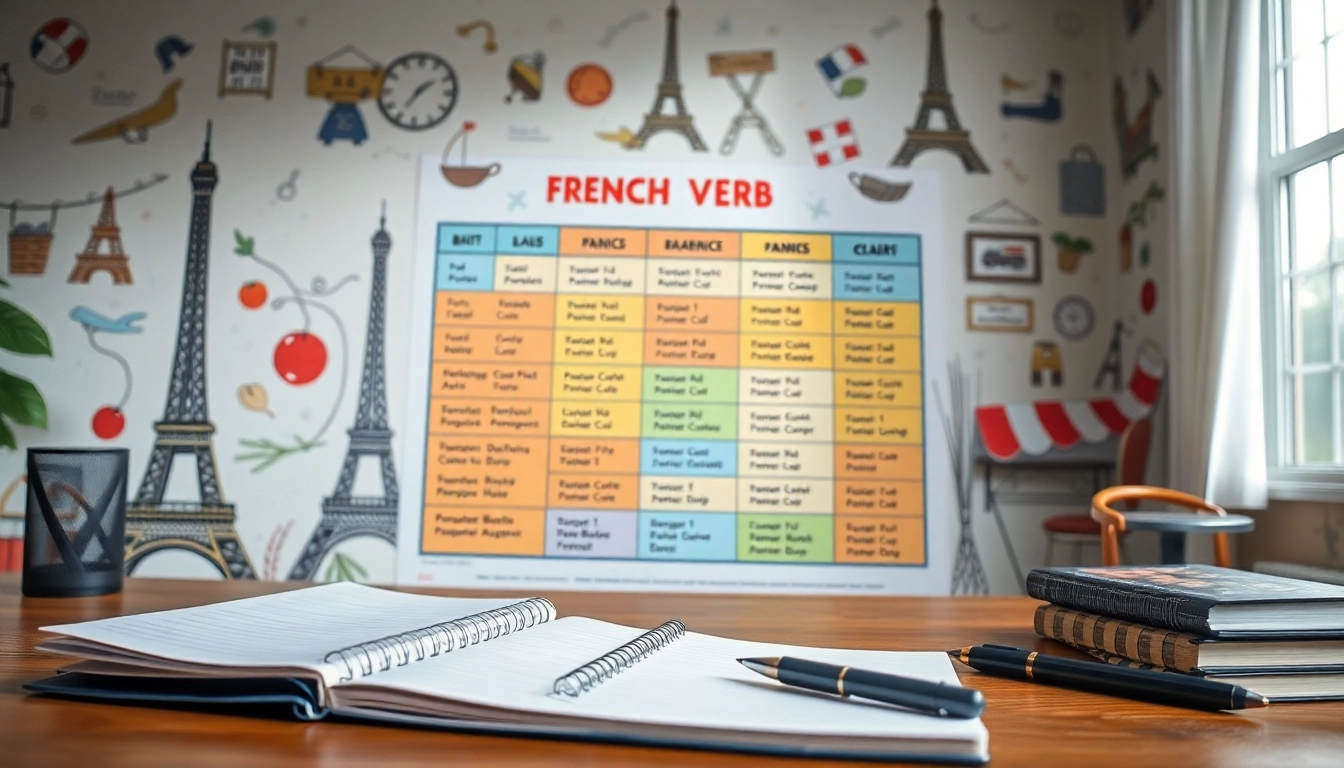Understanding French Verbs
Definition and Classification of French Verbs
At the core of the French language, French Verbs are vital building blocks. A verb, in essence, is an action or state of being, and in French grammar, these words are classified into various groups based on their conjugation patterns. Generally, French verbs fall into three primary categories: regular verbs, which follow predictable patterns, irregular verbs, which can deviate significantly from standard conjugation rules, and semi-regular verbs that exhibit characteristics of both categories. Understanding these classifications is essential for mastering the language’s grammatical structure.
Regular vs. Irregular French Verbs
Regular French verbs are those that conform to standard conjugation endings for specific groups. They can be categorized largely into three groups based on their infinitive endings: -er (like aimer, meaning “to love”), -ir (like finir, meaning “to finish”), and -re (like vendre, meaning “to sell”). For example, the regular verb aimer is conjugated as follows:
- Je aime (I love)
- Tu aimes (You love)
- Il/Elle/On aime (He/She/One loves)
- Nous aimons (We love)
- Vous aimez (You love)
- Ils/Elles aiment (They love)
On the other hand, irregular verbs do not follow these predictable patterns, which can make them particularly challenging for learners. Verbs such as être (to be) and avoir (to have) are prominent examples, as their conjugation forms are unique:
- Être: Je suis, Tu es, Il/Elle/On est, Nous sommes, Vous êtes, Ils/Elles sont
- Avoir: J’ai, Tu as, Il/Elle/On a, Nous avons, Vous avez, Ils/Elles ont
Knowing the difference between regular and irregular French verbs can significantly aid learners in their quest to master the language, as it lays a foundation for understanding conjugations and usage in various contexts.
Common Usage in Daily Conversation
French verbs are not merely for academic learning; they permeate everyday conversation, making them essential for effective communication. Understanding common verbs can enhance one’s ability to express needs, desires, actions, and states of being. Key verbs such as vouloir (to want), pouvoir (to be able to), and devoir (to have to/must) frequently arise in daily interactions. For instance, “Je veux un café” translates to “I want a coffee,” illustrating how these verbs facilitate basic needs and preferences in conversation.
Conjugating French Verbs
Basic Conjugation Patterns
To effectively communicate in French, mastering basic conjugation patterns is crucial. Each verb group follows specific endings based on the subject pronoun. The regular verbs are relatively straightforward, following a pattern like:
-er verbs: Drop -er and add:
- -e (Je)
- -es (Tu)
- -e (Il/Elle/On)
- -ons (Nous)
- -ez (Vous)
- -ent (Ils/Elles)
For -ir and -re verbs, the patterns differ, requiring learners to memorize these variations. Proficiency in these patterns means that learners can quickly and accurately form both present tense and other tenses as required.
Compound Tenses in French Verbs
French also employs compound tenses, commonly used to express actions that have been completed in the past. The compound tense generally combines an auxiliary verb (either être or avoir) and the past participle of the main verb. The choice of auxiliary usually depends on the verb. For instance:
- J’ai mangé (I ate) – using avoir
- Je suis allé(e) (I went) – using être
It’s worth noting that verbs that indicate motion or a change of state typically take être as the auxiliary verb. Understanding these compound structures enables learners to narrate past events, yielding a deeper engagement with the language.
Tackling Irregular French Verb Conjugation
Irregular verbs present unique challenges due to their unpredictable conjugation forms. For instance, the verb faire (to do/make) has conjugation forms that require memorization:
- Je fais
- Tu fais
- Il/Elle/On fait
- Nous faisons
- Vous faites
- Ils/Elles font
To tackle these challenges, learners might employ techniques such as flashcards, mnemonic devices, or regular practice through conversation. Utilizing these methods enhances recall and aids in faster acquisition of fluency.
Most Common French Verbs
Top 20 French Verbs You Should Know
To build a solid foundation in French, it’s invaluable to familiarize oneself with the most commonly used verbs. Here’s a list of the top 20 verbs often encountered in daily communication:
- Être – to be
- Avoir – to have
- Faire – to do/make
- Aller – to go
- Dire – to say/tell
- Voir – to see
- Savoir – to know (a fact)
- Vouloir – to want
- Pouvoir – to be able to/can
- Devoir – to have to/must
- Prendre – to take
- Donner – to give
- Répondre – to answer
- Habiter – to live
- Parler – to speak
- Aimer – to love/like
- Demander – to ask
- Penser – to think
- Regarder – to look/watch
- Écouter – to listen
Familiarizing with these verbs can dramatically improve one’s ability to participate in conversations and comprehend written content.
Usage Examples for Everyday Communication
Understanding the verbs is one thing, but knowing how to use them in context significantly enhances communication skills. Here are practical examples showcasing their use:
- J’ai un chat. (I have a cat.) – utilizing avoir
- Nous allons au cinéma. (We are going to the movies.) – employing aller
- Ils font leurs devoirs. (They are doing their homework.) – incorporating faire
- Elle aime voyager. (She loves to travel.) – using aimer
These examples highlight verbs in context, facilitating better understanding and usage for learners.
Mnemonics for Learning French Verbs
Learning a new language involves not just rote memorization but also creative techniques to retain information. Mnemonics serve as potent tools in this regard. For instance, to remember the verb être, one can associate it with the English word “essence,” linking the idea of being or existence. Similarly, visual aids can help solidify understanding; drawing pictures representing actions verbs can make them memorable.
Resources for Practicing French Verbs
Online Tools for Conjugation
As technology continues to advance, numerous online resources equip learners with efficient conjugation tools. Websites offering interactive conjugation tables demonstrate how various verbs change across tenses, allowing for focused practice. Checkbox systems that highlight correct or incorrect attempts can turn conjugation practice into a game-like experience, which may increase engagement. Exploring resources can significantly enhance learning outcomes.
Interactive Apps for Learning French Verbs
Mobile applications have revolutionized language learning, providing learners with access to lessons and practice on-the-go. Many reputable apps incorporate gamified elements, daily practice reminders, and interactive exercises tailored to build vocabulary and conjugation skills. Features like audio pronunciation support help bridge gaps for auditory learners, enabling responsive and enjoyable learning experiences.
Recommended Reading and Study Materials
In addition to digital resources, a variety of textbooks and workbooks cater to learners at different levels. Authentic materials, such as French novels, films, and music, also offer context and deepen understanding. Engaging with a mixture of reading, listening, and speaking exercises can help solidify the knowledge of verbs while enhancing general language proficiency.
Advanced Concepts in French Verbs
Subjunctive Mood and French Verbs
The subjunctive mood, often challenging for learners, denotes doubt, wish, necessity, or emotion. It plays a critical role in expressing phrases like “Il faut que” (It is necessary that) followed by a subjunctive verb form. For example:
- Il faut que j’aie (I have) → from avoir
- Il faut que tu sois (You are) → from être
Grasping the nuances of the subjunctive lends sophistication to conversational abilities, allowing for more breadth in expression.
Active vs. Passive Voice in French Verbs
French verbs can also be utilized in both active and passive voices. In the active voice, the subject performs the action (“Le chat chase la souris” – “The cat chases the mouse”), while in the passive voice, the subject receives the action (“La souris est chase par le chat” – “The mouse is chased by the cat”). This shift not only changes sentence structure but also can influence clarity, style, and nuance in communication.
Idiomatic Expressions Using French Verbs
French, rich in idiomatic expressions, uses verbs in fascinating ways that sometimes challenge direct translation. Phrases like avoir faim (to be hungry, literally “to have hunger”) or être en retard (to be late, literally “to be in delay”) illustrate how verbs interact with nouns to convey meaningful nuances. Familiarizing yourself with these expressions can enrich conversational skills and enhance fluency.


